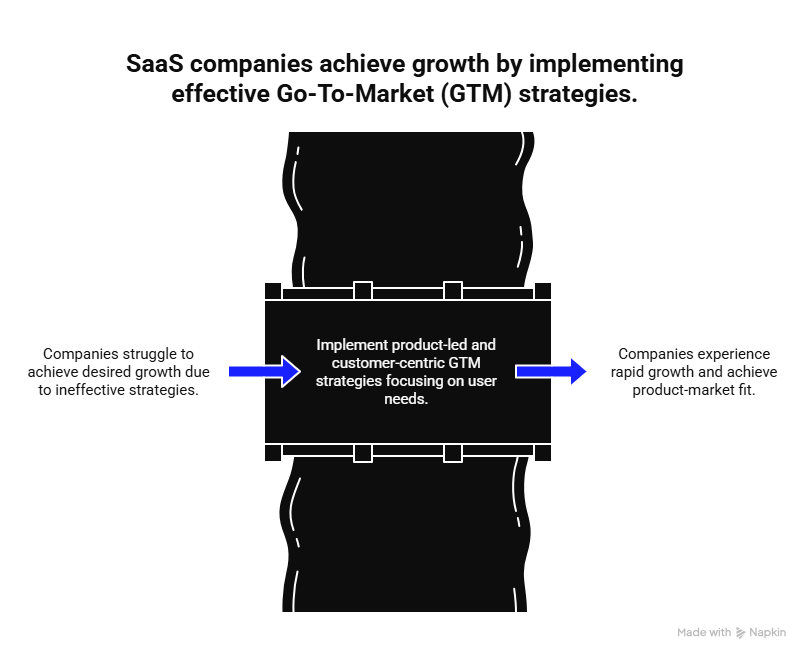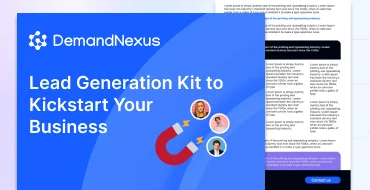Launching a SaaS product in the competitive B2B landscape requires more than a great idea—it demands a meticulously crafted go-to-market (GTM) strategy. A SaaS GTM strategy is your roadmap to capturing market share, driving revenue, and building lasting customer relationships. Whether you’re a startup introducing a new SaaS product or an enterprise SaaS company expanding into new markets, success hinges on aligning your product, marketing, and sales efforts with customer needs. This in-depth guide explores the essentials of a SaaS GTM strategy, covering product-led growth, sales-led approaches, channel selection, and key metrics, with insights from platforms like Reddit and a case study showcasing how
DemandNexus delivers results.
What Is a SaaS GTM Strategy?
A SaaS go-to-market strategy is a comprehensive plan that outlines how a SaaS company will launch its product, reach its target audience, and achieve a competitive edge in the B2B market. Unlike traditional software sales, SaaS GTM focuses on delivering ongoing value through subscriptions, emphasizing customer acquisition, retention, and scalability. It integrates marketing, sales, product development, and customer success to create a cohesive approach that drives revenue and fosters loyalty.

In B2B SaaS, the stakes are high. Buyers—ranging from startups to enterprises—expect solutions that solve specific pain points with measurable ROI. A well-executed GTM strategy ensures your SaaS product stands out, whether you’re leveraging product-led growth (PLG), sales-led motions, or a hybrid approach. Let’s break down the components and strategies that make it work.
Why a SaaS GTM Strategy Matters
A robust GTM strategy is critical for B2B SaaS companies because it:
- Aligns teams around a unified goal, ensuring marketing, sales, and product efforts work in sync.
- Maximizes resource efficiency by targeting the right audience through optimal channels.
- Accelerates market entry, helping you capture share before competitors.
- Drives predictable revenue through subscription models and retention strategies.
- Mitigates risks by anticipating market challenges and customer objections.
Without a GTM strategy, even the most innovative SaaS product can flounder, failing to reach its audience or justify its value.
Key Components of a SaaS GTM Strategy
Building a SaaS GTM strategy involves aligning several elements to create a cohesive plan. Here’s a breakdown of the core components:
| Component |
Description |
Example |
| Market Research |
Understand industry trends, customer needs, and competitors. |
Analyzing Reddit threads in r/SaaS for pain points. |
| Value Proposition |
Define how your product solves unique problems. |
Slack’s “Simplify team communication” messaging. |
| Target Audience |
Identify your ICP and buyer personas. |
Targeting mid-sized SaaS firms for a CRM tool. |
| Channels |
Select marketing and sales channels to reach customers. |
LinkedIn ads, webinars, or content marketing. |
| Pricing |
Set pricing that reflects value and market positioning. |
Freemium with premium upgrades, like Dropbox. |
Steps to Build a SaaS GTM Strategy
Creating a GTM playbook for your SaaS product involves a structured approach. Follow these steps to craft a strategy that drives growth:
1. Conduct Deep Market Research
Start by understanding your market. Dive into industry reports, customer surveys, and competitor analyses to identify trends and gaps. Platforms like Reddit, particularly subreddits like r/SaaS or r/Entrepreneur, offer raw insights into customer pain points and preferences. For example, a Reddit thread might reveal that B2B buyers prioritize integrations over flashy features, guiding your product focus.
2. Define Your Ideal Customer Profile (ICP)
Pinpoint who your SaaS product serves. Create an ICP that details company size, industry, revenue, and challenges. For an enterprise SaaS, your ICP might be Fortune 500 companies with complex workflows, while a startup SaaS might target SMBs with lean budgets. Build buyer personas to flesh out decision-makers’ roles, goals, and pain points.
3. Craft a Compelling Value Proposition
Your value proposition should clearly articulate why your SaaS product is the best solution. Focus on benefits, not features. For instance, instead of “Our tool has AI analytics,” say “Boost revenue by 20% with AI-driven insights.” Test your messaging on platforms like LinkedIn or Reddit to ensure it resonates.
4. Choose the Right Marketing and Sales Channels
Select channels that align with your audience’s behavior. For B2B SaaS, effective channels include:
- Content Marketing: Publish blogs, eBooks, or videos to educate prospects, as seen in HubSpot’s inbound strategy.
- LinkedIn Ads: Target decision-makers with precise display advertising.
- Webinars: Host live sessions to showcase expertise, like ZoomInfo’s industry-focused events.
- SEO: Optimize for high-intent keywords to drive organic traffic.
- Cold Outreach: Use cold email or cold calling for high-value accounts.
5. Develop a Pricing Strategy
Pricing impacts adoption and revenue. Options include freemium (like Slack), tiered plans (like Asana), or value-based pricing for enterprise SaaS (like Salesforce). Analyze competitors and test pricing on Reddit or through customer surveys to find the sweet spot.
6. Align Sales and Marketing
Ensure your
SaaS marketing funnel feeds qualified leads to your sales team. Equip reps with enablement tools like pitch decks and case studies, as offered by
B2B sales enablement services. Use a CRM like HubSpot to track interactions and streamline handoffs.
7. Launch and Iterate
Execute a coordinated launch, aligning marketing campaigns, sales outreach, and product updates. Consider a phased rollout, like Notion’s alpha releases, to gather feedback and refine. Post-launch, use analytics to track performance and iterate based on customer insights.
Product-Led Growth vs. Sales-Led Growth
SaaS GTM strategies often fall into two camps: product-led growth (PLG) and sales-led growth. Here’s how they compare:
| Approach |
Description |
Best For |
Example |
| Product-Led Growth |
Drives adoption through a free or freemium product, emphasizing user experience and virality. |
SMBs, startups, or low-touch products. |
Slack’s freemium model. |
| Sales-Led Growth |
Relies on sales teams to close high-value deals with personalized outreach. |
Enterprise SaaS or complex solutions. |
Salesforce’s enterprise focus. |
Many SaaS companies blend both. For example, Zoom uses PLG with a free tier to attract users, then upsells enterprises through sales-led efforts. Choose based on your product complexity and target market.
Key Market Metrics to Track
Measuring your GTM strategy’s success requires tracking the right metrics. Focus on these KPIs:
| Metric |
Formula |
Why It Matters |
| Monthly Recurring Revenue (MRR) |
Sum of monthly subscription revenue |
Tracks revenue growth |
| Customer Acquisition Cost (CAC) |
(Marketing + Sales Costs) / New Customers |
Measures efficiency of acquisition |
| Churn Rate |
(Lost Customers / Total Customers) * 100 |
Indicates retention success |
| Conversion Rate |
(Conversions / Total Leads) * 100 |
Gauges funnel effectiveness |
Use tools like Google Analytics or Userpilot to monitor these metrics and identify areas for improvement. For example, a high CAC might signal a need to optimize channels like
demand generation.
Case Study: DemandNexus Powers GTM for a SaaS Collaboration Tool
A mid-sized SaaS company launching a collaboration tool struggled to gain traction in a crowded market. Their initial GTM efforts lacked focus, resulting in low lead quality and stagnant revenue.
DemandNexus stepped in to transform their approach.
- Challenge: Poor market positioning and ineffective channel mix, with only 15% of leads converting to trials.
- Solution: DemandNexus conducted market research via Reddit and LinkedIn to refine the ICP. They implemented a hybrid GTM with PLG (freemium model) and targeted account-based marketing for enterprises. They also launched SEO-optimized content and LinkedIn ads to drive traffic.
- Results: Trial sign-ups increased by 40%, conversion rates rose to 30%, and MRR grew by 35% in six months.
DemandNexus’s data-driven GTM solutions, from
lead nurturing to channel optimization, help SaaS companies achieve product-market fit. Their expertise can guide your launch to success.
Lessons from Reddit: Real-World GTM Insights
Reddit’s r/SaaS and r/Entrepreneur communities offer unfiltered perspectives on GTM strategies. Common themes include:
- Simplicity Wins: Users praise SaaS products with intuitive onboarding, like Notion’s all-in-one workspace.
- Community Matters: Engaging with niche communities builds trust, as seen with Userpilot’s LinkedIn presence.
- Feedback Fuels Iteration: SaaS founders stress the importance of customer feedback loops to refine GTM tactics.
Your SaaS GTM Playbook
A successful SaaS GTM strategy blends market insight, customer focus, and agile execution. Start by researching your audience and crafting a value proposition that resonates. Choose channels that align with your ICP, whether it’s content marketing, LinkedIn, or
event marketing. Balance PLG and sales-led approaches to maximize reach, and track metrics to iterate relentlessly. With a clear playbook, your SaaS product can dominate its market.
Ready to launch with confidence?
DemandNexus offers tailored GTM solutions, from market research to lead generation, to drive B2B SaaS growth. Contact them today to build a strategy that delivers revenue and impact.
 In B2B SaaS, the stakes are high. Buyers—ranging from startups to enterprises—expect solutions that solve specific pain points with measurable ROI. A well-executed GTM strategy ensures your SaaS product stands out, whether you’re leveraging product-led growth (PLG), sales-led motions, or a hybrid approach. Let’s break down the components and strategies that make it work.
In B2B SaaS, the stakes are high. Buyers—ranging from startups to enterprises—expect solutions that solve specific pain points with measurable ROI. A well-executed GTM strategy ensures your SaaS product stands out, whether you’re leveraging product-led growth (PLG), sales-led motions, or a hybrid approach. Let’s break down the components and strategies that make it work.
 In B2B SaaS, the stakes are high. Buyers—ranging from startups to enterprises—expect solutions that solve specific pain points with measurable ROI. A well-executed GTM strategy ensures your SaaS product stands out, whether you’re leveraging product-led growth (PLG), sales-led motions, or a hybrid approach. Let’s break down the components and strategies that make it work.
In B2B SaaS, the stakes are high. Buyers—ranging from startups to enterprises—expect solutions that solve specific pain points with measurable ROI. A well-executed GTM strategy ensures your SaaS product stands out, whether you’re leveraging product-led growth (PLG), sales-led motions, or a hybrid approach. Let’s break down the components and strategies that make it work.



